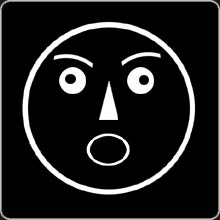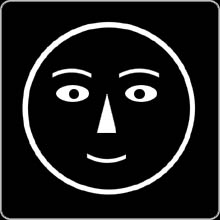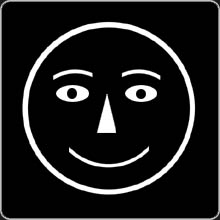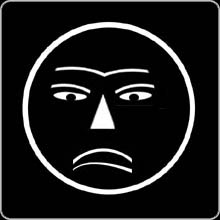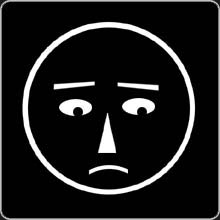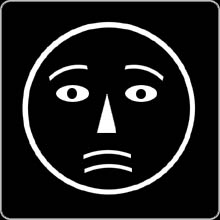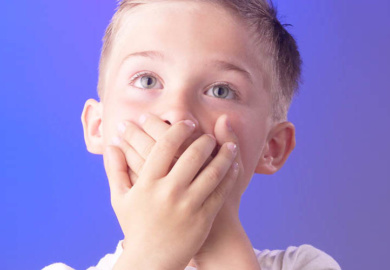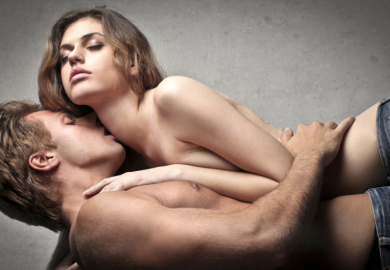Facial Expressions Basics
Silvan Tomkins, world recognised guru on emotional states, (1911 – 1991), believed that there are eight basic expressions which are:
1) Surprise, 2) Interest, 3) Joy, 4) Rage, 5) Fear, 6) Disgust, 7) Shame, 8) Anguish
The chalk picto-faces on this page have been drawn with deliberate simplicity to show how a circle with only a few lines within it can be recognised as a distinctive facial expression with a strong corresponding emotion. It is important to note that humans actually use a far wider range of facial expressions than the eight depicted on this page.
SURPRISE
The eyebrows are lifted so they become curved and central to the forehead. The skin underneath is stretched and horizontal wrinkles appear across the forehead. The eyelids open and the upper lids are raised while the lower lids are brought down. The jaw is dropped so that the lips and teeth are parted creating the effect of a slack jaw. The head is often tilted and the eyes raised. If the head is forward it indicates disbelief – if the head is pulled back it indicates fear. Usually this facial expression is swiftly replaced by a reactionary expression.
INTEREST
This facial expression is essentially neutral and by definition open to information – i.e. interest. There are some indicators – a half smile and a slight widening of the eyes. The forehead and the eyebrows are the kinesics to observe. A slight frown indicates concentration rather than disbelief. However, should the eyes narrow and the frown become more obvious then the person is clearly having difficulty “absorbing and accepting the incoming information. The more informed or educated a person becomes, the more difficult it is for them to blindly accept new input.
JOY / THE SMILE
Joy is an emotion of sincere happiness. The key visual component of this emotional state is the smile. Still, “Why do we smile?” Almost all animals don’t smile. Baring the teeth is actually an aggressive facial signal. This is a great psychological question and there isn’t yet a fully convincing answer. It might be as simple as dental health. Good teeth may indicate a good mate or it may have to do with submissive / aggressive behaviour patterns. It is perhaps the most inexplicable body language signal and simply taken for granted.
ANGER / RAGE
“If you have to fight then win at any cost. You cannot defend your actions tomorrow if you die today.” An ancient wisdom from Japan. Anger is the precursor to Rage. Anger is the warning – Rage is the result. The eyes narrow and the eyebrows form the classic V shape. The lips tighten. The face prepares for combat. Adrenaline floods the body preparing muscles for violence while endorphins prepare the body for pain. Hate, a desire to inflict hurt and a denial of consequences. This is rage – the mindset of the berserker. No mercy – one victor!”
FEAR
A frozen stare, wild and wide-open eyes, face pale, face pulled back, chills, sweating and hair standing on end. These are all some of the components that make up the facial expression of fear or terror. A cliché in English literature is: “His face was a mask of terror.” This is because the face does, for a moment, actually take on a mask-like appearance. For an instant the person freezes like a rabbit caught in the glare of a car’s headlights (stay still and the predator might not see you) and then adrenaline floods the system and the person flees or fights.
DISGUST
Dr Valerie Curtis of the London School of Hygiene and Tropical Medicine discovered that people worldwide found a range of things that were consistently considered disgusting. These were: Body secretions (vomit, pus, sexual fluids, etc), body parts and blood, anything rotting, certain insects and animals, (lice, rats, and flies), contagious or contaminated people. She drew the conclusion that disgust is a survival instinct that repels people from disease. As such the expression of disgust may be an attempt to close of the nose and eyes from contact with the contagion.
SHAME
Shame, guilt and humiliation have almost identical facial expressions. The person looks down and to the side to avoid meeting the eyes of other people. The eyebrows arch outwards in a non-aggressive expression and the mouth droops in sorrow. Usually the head is tilted forward or bowed. These emotions occur when an individual realises they have been identified in an indefensible “wrong doing”. This usually occurs when the person is “caught out” by others but can happen when the person recognises internally they have done wrong.
ANGUISH
The Merriam Webster dictionary describes Anguish as: Extreme (emotional) pain, distress or anxiety. Anguish can also be described as an overwhelming sadness or sorrow. The facial expression depicted to the left is a simple representation of the way that the face alters (often uncontrollably) when this emotional state occurs. Tomkins describes the physical manifestation as: Crying or rhythmic sobbing, arched eyebrows, mouth slightly open and lips turned down. No picto-face can begin to describe the intensity of this expression.
Continued from top of page …
Facial expressions are the foundations of body language. Some are instinctive and some are learned by watching others and then mimicking them. It’s a fact that children see the gestures used by their parents and copy them as natural behaviour.
As usual, scientists and researchers disagree on the exact number of basic facial expressions. Charles Darwin is recognised as publishing the first serious scientific study in 1872 and in his work “the Expression of Emotions in Man and Animals” he claims to have identified 13 that can be considered universal. These are: astonishment, shame, fear, horror, pride, hatred, wrath, love, joy, guilt, anxiety, shyness, and modesty.
It’s worth noting that many other people before Darwin appreciated the importance of facial expressions and their link to human emotions.
“Beauty without expression is boring.”
This was proposed by Ralph Waldo Emerson an American Poet, Lecturer and Essayist who lived between 1803-1882.
“Sweet babe, in thy face soft desires I can trace, secret joys and secret smiles, little pretty infant wiles” (From the poem Sleep! Sleep! Beauty Bright) This was written by William Blake an English visionary, Mystic, Poet, Painter and Engraver who lived between 1757-1827. He clearly understood the importance of facial expressions.


